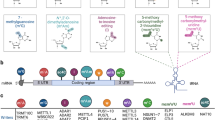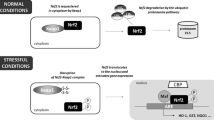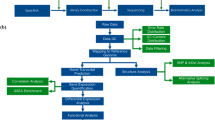Abstract
Cellular senescence plays a causal role in ageing and, in mice, depletion of p16INK4a-expressing senescent cells delays ageing-associated disorders1,2. Adenosine deaminases acting on RNA (ADARs) are RNA-editing enzymes that are also implicated as important regulators of human ageing, and ADAR inactivation causes age-associated pathologies such as neurodegeneration in model organisms3,4. However, the role, if any, of ADARs in cellular senescence is unknown. Here we show that ADAR1 is post-transcriptionally downregulated by autophagic degradation to promote senescence through p16INK4a upregulation. The ADAR1 downregulation is sufficient to drive senescence in both in vitro and in vivo models. Senescence induced by ADAR1 downregulation is p16INK4a-dependent and independent of its RNA-editing function. Mechanistically, ADAR1 promotes SIRT1 expression by affecting its RNA stability through HuR, an RNA-binding protein that increases the half-life and steady-state levels of its target mRNAs. SIRT1 in turn antagonizes translation of mRNA encoding p16INK4a. Hence, downregulation of ADAR1 and SIRT1 mediates p16INK4a upregulation by enhancing its mRNA translation. Finally, Adar1 is downregulated during ageing of mouse tissues such as brain, ovary and intestine, and Adar1 expression correlates with Sirt1 expression in these tissues in mice. Together, our study reveals an RNA-editing-independent role for ADAR1 in the regulation of senescence by post-transcriptionally controlling p16INK4a expression.





Similar content being viewed by others
Data availability
RNA-seq datasets have been deposited in the Gene Expression Omnibus (GEO) under the accession number GSE179423. Source data are provided with this paper. All other data supporting the findings of this study are available from the corresponding authors on reasonable request.
Code availability
The software and algorithms for data analyses used in this study are all well-established from previous work and are referenced throughout the manuscript.
References
Kim, W. Y. & Sharpless, N. E. The regulation of INK4/ARF in cancer and aging. Cell 127, 265–275 (2006).
Baker, D. J. et al. Clearance of p16Ink4a-positive senescent cells delays ageing-associated disorders. Nature 479, 232–236 (2011).
Deng, P. et al. Adar RNA editing-dependent and -independent effects are required for brain and innate immune functions in Drosophila. Nat. Commun. 11, 1580 (2020).
Sebastiani, P. et al. RNA editing genes associated with extreme old age in humans and with lifespan in C. elegans. PLoS ONE 4, e8210 (2009).
Herranz, N. & Gil, J. Mechanisms and functions of cellular senescence. J. Clin. Invest. 128, 1238–1246 (2018).
He, S. & Sharpless, N. E. Senescence in health and disease. Cell 169, 1000–1011 (2017).
Bussian, T. J. et al. Clearance of senescent glial cells prevents tau-dependent pathology and cognitive decline. Nature 562, 578–582 (2018).
Nishikura, K. Functions and regulation of RNA editing by ADAR deaminases. Annu. Rev. Biochem. 79, 321–349 (2010).
Nishikura, K. A-to-I editing of coding and non-coding RNAs by ADARs. Nat. Rev. Mol. Cell Biol. 17, 83–96 (2016).
Sakurai, M. et al. ADAR1 controls apoptosis of stressed cells by inhibiting Staufen1-mediated mRNA decay. Nat. Struct. Mol. Biol. 24, 534–543 (2017).
Khan, A. et al. Membrane and synaptic defects leading to neurodegeneration in Adar mutant Drosophila are rescued by increased autophagy. BMC Biol. 18, 15 (2020).
Amaravadi, R. K. & Winkler, J. D. Lys05: a new lysosomal autophagy inhibitor. Autophagy 8, 1383–1384 (2012).
Dou, Z. et al. Autophagy mediates degradation of nuclear lamina. Nature 527, 105–109 (2015).
Xu, C. et al. SIRT1 is downregulated by autophagy in senescence and ageing. Nat. Cell Biol. 22, 1170–1179 (2020).
Pankiv, S. et al. p62/SQSTM1 binds directly to Atg8/LC3 to facilitate degradation of ubiquitinated protein aggregates by autophagy. J. Biol. Chem. 282, 24131–24145 (2007).
Narita, M. et al. Rb-mediated heterochromatin formation and silencing of E2F target genes during cellular senescence. Cell 113, 703–716 (2003).
Zhang, R. et al. Formation of MacroH2A-containing senescence-associated heterochromatin foci and senescence driven by ASF1a and HIRA. Dev. Cell 8, 19–30 (2005).
Lai, F., Drakas, R. & Nishikura, K. Mutagenic analysis of double-stranded RNA adenosine deaminase, a candidate enzyme for RNA editing of glutamate-gated ion channel transcripts. J. Biol. Chem. 270, 17098–17105 (1995).
Martin, N., Beach, D. & Gil, J. Ageing as developmental decay: insights from p16INK4a. Trends Mol. Med. 20, 667–674 (2014).
Huang, J. et al. SIRT1 overexpression antagonizes cellular senescence with activated ERK/S6k1 signaling in human diploid fibroblasts. PLoS ONE 3, e1710 (2008).
Li, Y. & Tollefsbol, T. O. p16INK4a suppression by glucose restriction contributes to human cellular lifespan extension through SIRT1-mediated epigenetic and genetic mechanisms. PLoS ONE 6, e17421 (2011).
Wang, I. X. et al. ADAR regulates RNA editing, transcript stability, and gene expression. Cell Rep. 5, 849–860 (2013).
Fan, X. C. & Steitz, J. A. Overexpression of HuR, a nuclear-cytoplasmic shuttling protein, increases the in vivo stability of ARE-containing mRNAs. EMBO J. 17, 3448–3460 (1998).
Zhang, Z. et al. Activation of ferritinophagy is required for the RNA-binding protein ELAVL1/HuR to regulate ferroptosis in hepatic stellate cells. Autophagy 14, 2083–2103 (2018).
Levine, B. & Kroemer, G. Autophagy in the pathogenesis of disease. Cell 132, 27–42 (2008).
Fernandez, A. F. et al. Disruption of the beclin 1–BCL2 autophagy regulatory complex promotes longevity in mice. Nature 558, 136–140 (2018).
Lin, S. J., Defossez, P. A. & Guarente, L. Requirement of NAD and SIR2 for life-span extension by calorie restriction in Saccharomyces cerevisiae. Science 289, 2126–2128 (2000).
Tissenbaum, H. A. & Guarente, L. Increased dosage of a sir-2 gene extends lifespan in Caenorhabditis elegans. Nature 410, 227–230 (2001).
Rogina, B. & Helfand, S. L. Sir2 mediates longevity in the fly through a pathway related to calorie restriction. Proc. Natl Acad. Sci. USA 101, 15998–16003 (2004).
Dou, Z. et al. Cytoplasmic chromatin triggers inflammation in senescence and cancer. Nature 550, 402–406 (2017).
Zhang, R., Chen, W. & Adams, P. D. Molecular dissection of formation of senescence-associated heterochromatin foci. Mol. Cell. Biol. 27, 2343–2358 (2007).
Mitra, M., Ho, L. D. & Coller, H. A. An in vitro model of cellular quiescence in primary human dermal fibroblasts. Methods Mol. Biol. 1686, 27–47 (2018).
Hari, P. et al. The innate immune sensor Toll-like receptor 2 controls the senescence-associated secretory phenotype. Sci. Adv. 5, eaaw0254 (2019).
Liu, P. et al. m6A-independent genome-wide METTL3 and METTL14 redistribution drives the senescence-associated secretory phenotype. Nat. Cell Biol. 23, 355–365 (2021).
Cheng, L. C. et al. Alternative 3′ UTRs play a widespread role in translation-independent mRNA association with the endoplasmic reticulum. Cell Rep. 36, 109407 (2021).
Weng, H. et al. METTL14 inhibits hematopoietic stem/progenitor differentiation and promotes leukemogenesis via mRNA m6A modification. Cell Stem Cell 22, 191–205 (2018).
Langmead, B. & Salzberg, S. L. Fast gapped-read alignment with Bowtie 2. Nat. Methods 9, 357–359 (2012).
Li, B. & Dewey, C. N. RSEM: accurate transcript quantification from RNA-Seq data with or without a reference genome. BMC Bioinform. 12, 323 (2011).
Love, M. I., Huber, W. & Anders, S. Moderated estimation of fold change and dispersion for RNA-seq data with DESeq2. Genome Biol. 15, 550 (2014).
Koboldt, D. C. et al. VarScan 2: somatic mutation and copy number alteration discovery in cancer by exome sequencing. Genome Res. 22, 568–576 (2012).
Kang, T. W. et al. Senescence surveillance of pre-malignant hepatocytes limits liver cancer development. Nature 479, 547–551 (2011).
Acknowledgements
We thank C. Liang for critical reading of the manuscript and comments. This work was supported by US National Institutes of Health grants (grant nos R01CA160331 to R.Z.; P01AG031862 to P.D.A., S.L.B and R.Z.; R01GM040536 and R01GM130716 to K.N.; and R50CA211199 to A.V.K.). K.N. was supported by a grant from Emerson Collective. Support of Core Facilities was provided by Cancer Centre Support Grant (CCSG) CA010815 to The Wistar Institute.
Author information
Authors and Affiliations
Contributions
X.H., P.L. and R.Z. designed the experiments. X.H., M.T., Q.Z., S.W. and P.L. performed the experiments and analysed data. A.V.K. performed the bioinformatic analysis. Y.S. and M.S. contributed to study design. L.W. and A.H. contributed key experimental materials and design. X.H., L.W., P.D.A., K.N., S.B., P.L., A.V.K. and R.Z. wrote the manuscript. P.D.A., S.B., B.T., K.N., P.L. and R.Z. supervised the studies. R.Z. conceived the study.
Corresponding authors
Ethics declarations
Competing interests
The authors have no competing interests.
Peer review
Peer review information
Nature Cell Biology thanks Masashi Narita, Rajat Singh, and the other, anonymous reviewer(s) for their contribution to the peer review of this work. Peer reviewer reports are available.
Additional information
Publisher’s note Springer Nature remains neutral with regard to jurisdictional claims in published maps and institutional affiliations.
Extended data
Extended Data Fig. 1 ADAR1 downregulation during senescence.
a, Expression of ADAR1 in the indicated control proliferating and quiescent IMR90 cells induced by contact inhibition and serum starvation was determined by immunoblot analysis. The experiment was repeated three times independently with similar results. b, Expression of ADAR2 in control proliferating (PD30), replicative senescent (PD80), and RAS-induced senescent IMR90 cells was determined by immunoblot. Mouse brain tissue was used as a positive control for ADAR2 expression. The experiment was repeated three times independently with similar results. c, IMR90 cells were induced to senesce by Etoposide (100 μM for 48 h) and examined for expression of the indicated proteins by immunoblot at the indicated point points. The experiment was repeated three times independently with similar results. d-h, IMR90 cells expressing the indicated sgRNAs were analysed for expression of the indicated proteins by immunoblot (d), or stained for SA-β-gal activity (e). Percentages of SA-β-Gal positive cells were quantified (from > 200 cells) (f). The indicated cells were also subjected to colony formation assay to determine senescence-associated growth arrest (g), and the intensity of colony formed by the indicated cells was quantified by NIH ImageJ software (h). Scale bars = 100 μm. i-j, Mouse embryonic fibroblasts isolated from wildtype control and Adar1 knockout mouse were stained for SA-β-Gal activity (i). Percentages of SA-β-Gal positive cells were quantified (from > 200 cells) (j). Scale bars = 100 μm. k-l, Schematic of the construct used to knock down Adar1 expression in mouse (k) and outline of hydrodynamic tail vein injection to induce senescence by Adar knockdown in mouse liver (l). m, Validation of Adar1 knockdown in mouse cells. Mouse ID8 cells expressing the indicated shControl or shAdar1 were examined for expression of the indicated proteins. n-o, ADAR1 mRNA expression was determined by RT-qPCR analysis RAS-induced senescent IMR90 cells (n) or Etoposide induced senescent IMR90 cells (o). Data represent the mean ± s.d. of three biologically independent experiments. P values were calculated using a two-tailed Student’s t-test. Source numerical data and unprocessed blots are available in source data.
Extended Data Fig. 2 Autophagy contributes to ADAR1 downregulation during senescence.
a-b, Expression of the indicated proteins was determined by immunoblot in IMR90 cells treated with vehicle control or etoposide to induce senescence with or without simultaneous treatment of Lys05 (a) and relative ADAR1 levels were quantified (b). The experiment was repeated three times independently with similar results. c-d, Expression of the indicated protein was determined by immunoblot in proliferating (PD28) and replicative senescent (PD73) IMR90 cells treated with or without Leupeptin (c) and relative ADAR1 levels were quantified (d). The experiment was repeated three times independently with similar results. e, Expression of the indicated proteins was determined by immunoblot in young and proliferative IMR90 (PD30) treated with or without Lys05 (e). The experiment was repeated three times independently with similar results. f-g, Expression of the indicated proteins was determined by immunoblot in IMR90 cells induced to undergo senescence by oncogenic H-RASG12V with or without expressing shATG7 (f) and relative ADAR1 levels were quantified (g). h-k, Expression of the indicated proteins was determined by immunoblot in control early passage proliferating or late passage replicative senescent IMR90 (h) or WI38 cells (j) with or without ATG7 knockdown. And relative ADAR1 levels were quantified in i and k. l-m, Representative confocal images of immunostaining of endogenous ADAR1 and LC3 in control proliferating and RAS-induced senescent IMR90 (l). And the percentage of cells with co-localization of cytoplasmic ADAR1 puncta and LC3 (as exemplified by arrows pointed puncta) were quantified in 4 independent biological repeats (m). n, Co-immunoprecipitation analysis between ADAR1 and LC3 in cytoplasmic extracts from the indicated proliferating (PD21) and replicative senescent (PD68) IMR90 cells. Downregulation of ADAR1 was validated in whole cell lysates. o, IMR90 cells transfected with mCherry-ADAR1 p150 were induced senescence by expressing oncogenic H-RASG12V. Localization of mCherry-ADAR1p150 was visualized and DAPI counter staining was used to visualize nuclei. Scale bars = 10 μm. Data represent the mean ± s.e.m. of three biologically independent experiments unless otherwise stated. P values were calculated using a two-tailed Student’s t-test. Source numerical data and unprocessed blots are available in source data.
Extended Data Fig. 3 ADAR1 downregulation does not induce robust SASP.
a, Immunostaining for macroH2A1.2 in IMR90 cells with or without ADAR1 knockdown (shADAR1 #1). Scale bar = 10 μm. Asterisks indicated inactivated X chromosome in female IMR90 cells and arrows indicate examples of macroH2A1.2 positive SAHF. The experiment was repeated three times independently with similar results. b-c, Immunostaining for macroH2A1.2 in control proliferating and replicative senescent WI38 cells with or without ATG7 knockdown (b). Cells with macroH2A1.2 positive foci were quantified (> 200 cells) (c). Scale bar = 10 μm. d, Global RNA A/I editing was analysed based on the RNA-seq A/G reads in the indicated cells. e, Changes in expression of SASP genes in the indicated ADAR1 knockdown vs. control IMR90 cells (KD/Ctr) determined by RNA-seq analysis. SASP genes with at least 10 counts at least 1 FPKM level are reported. f, Secreted cytokines in conditioned media from IMR90 cells with or without ADAR1 knockdown (shADAR1 #1) was detected using an antibody-based cytokine array. Conditioned media collected from RAS-induced senescent IMR90 cells was used as a positive control. g-h, Expression of the indicated proteins was determined by immunoblot in IMR90 cells expressing shControl or shADAR1s (g) or sgGFP control or sgADAR1 (h). The experiment was repeated three times independently with similar results. i-j, Representative images of SA-β-gal staining of IMR90 cells cultured with conditioned media from indicated cells (i). Percentages of SA-β-gal positive cells were quantified (from > 200 cells) (j). k-m, IMR90 cells expressing shControl or shADAR1 (#1) with or without ectopically expression of wildtype ADAR1 p110 or a deaminase inactive mutant E912A ADAR1 p110 were analysed for SA-β-Gal activity (k) and positive cells were quantified (from > 200 cells) (l). In addition, the indicated cells were subjected to colony formation assay (m). Scale bars = 100 μm. Data represent the mean ± s.d. in l and m, or s.e.m. in c and j of three biologically independent experiments. P values were calculated using a two-tailed Student’s t-test. P values were calculated using a two-tailed Student’s t-test. Source numerical data and unprocessed blots are available in source data.
Extended Data Fig. 4 ADAR1 regulates SIRT1 expression.
a, Expression of p16INK4a mRNA expression was analysed by RT-qPCR in the indicated IMR90 cells. b, Heatmap visualization of detected (at least 10 read counts and 1 FPKM) and differentially expressed genes (> 2-fold) between IMR90 cells expressing shControl or shADAR1 as determined by the RNA-seq analysis. c, Expression of SIRT1 mRNA was analysed by RT-qPCR in the indicated IMR90 cells. d, Heatmap of HuR-associated mRNAs that are significantly reduced by ADAR1 knockdown in IMR90 cells. List of 5 genes related to autophagy pathway was included in the top and the top 25 of the rest of genes identified were listed. IMR90 cells expressing shHuR were used as a positive control. e-f, Expression of the indicated proteins was determined by immunoblot in the IMR90 cells expressing shControl or the indicated shHuR (e) and relative ADAR1 levels were quantified (f). g, Immunoblot of HuR in IMR90 cells with the indicated treatment immunoprecipitated by an anti-HuR antibody. An isotype matched IgG was used as a negative control. h, Expression of the indicated proteins was determined by immunoblot in the indicated IMR90 cells. Data represent the mean ± s.d. in a and c and ± s.e.m. of three biologically independent experiments. P values were calculated using a two-tailed Student’s t-test. Source numerical data and unprocessed blots are available in source data.
Extended Data Fig. 5 Age-associated downregulation of Adar1.
a, Expression of the indicated proteins was determined by immunoblot in the indicated tissues harvested from young (4 months) and aged (24 months) mice. The experiment was repeated two times independently with similar results. b-c, The cortex tissues from brains of young (4 months) and aged (24 months) mice were analysed for expression of the indicated proteins by immunoblot. The intensity of Adar2 (b) or Adar3 (c) immunoblot was quantified by NIH ImageJ software in young and aged mouse cortex tissues and normalized against a loading control β-actin expression. d-g, Expression of Adar1 and Sirt1 was determined by immunoblot in the intestine tissues harvested from young mice (4 months), and aged mice (20 months) treated with either vehicle PBS control or Lys05 (10 mg/kg daily) for 2 weeks (d). The intensity of Adar1 (e) and Sirt1 (f) immunoblot was quantified using NIH ImageJ software in indicated groups by normalizing against a loading control β-actin expression. Correlation between Adar1 and Sirt1 protein expression as determined by a two-sided Pearson correlation analysis (g). n = 5 biologically independent mice per group. h-i, Expression of Adar1 mRNA was analysed by RT-qPCR in ovaries (h) and intestines (i) from young (4 months) and aged mice (20 months) treated with either vehicle PBS control or Lys05. j-m, Expression of p62 was determined by immunoblot in ovaries (j) and intestines (l) from young mice (4 months) and aged mice (20 months) treated with either vehicle PBS control or Lys05. The intensity of p62 immunoblot in ovaries (k) and intestines (m) was quantified using NIH ImageJ software by normalizing against a loading control β-actin expression. n = 5 biologically independent mice per group. Data represent the mean ± s.d. in b, c, e and f, or s.e.m. in h, I, k and m of biologically independent experiments. P values were calculated using a two-tailed Student’s t-test. Source numerical data and unprocessed blots are available in source data.
Supplementary information
Supplementary Tables 1,2
Supplementary Table 1. List of HuR target genes whose association with HuR was significantly decreased by ADAR1 knockdown, identified through anti-HuR immunoprecipitation, followed by RNA-seq analysis. HuR knockdown was used as a positive control for the analysis. Supplementary Table 2. List of the sgRNAs and primers used in this study.
Source data
Statistical Source Data Fig. 1
Statistical source data.
Unprocessed Blots Fig. 1
Unprocessed western blots.
Statistical Source Data Fig. 2
Statistical source data.
Unprocessed Blots Fig. 2
Unprocessed western blots.
Statistical Source Data Fig. 3
Statistical source data.
Unprocessed Blots Fig. 3
Unprocessed western blots.
Statistical Source Data Fig. 4
Statistical source data.
Unprocessed Blots Fig. 4
Unprocessed western blots.
Statistical Source Data Fig. 5
Statistical source data.
Unprocessed Blots Fig. 5
Unprocessed western blots.
Statistical Source Data Extended Data Fig. 1
Statistical source data.
Unprocessed Blots Extended Data Fig. 1
Unprocessed western blots.
Statistical Source Data Extended Data Fig. 2
Statistical source data.
Unprocessed Blots Extended Data Fig. 2
Unprocessed western blots.
Statistical Source Data Extended Data Fig. 3
Statistical source data.
Unprocessed Blots Extended Data Fig. 3
Unprocessed western blots.
Statistical Source Data Extended Data Fig. 4
Statistical source data.
Unprocessed Blots Extended Data Fig. 4
Unprocessed western blots.
Statistical Source Data Extended Data Fig. 5
Statistical source data.
Unprocessed Blots Extended Data Fig. 5
Unprocessed western blots.
Rights and permissions
About this article
Cite this article
Hao, X., Shiromoto, Y., Sakurai, M. et al. ADAR1 downregulation by autophagy drives senescence independently of RNA editing by enhancing p16INK4a levels. Nat Cell Biol 24, 1202–1210 (2022). https://doi.org/10.1038/s41556-022-00959-z
Received:
Accepted:
Published:
Issue Date:
DOI: https://doi.org/10.1038/s41556-022-00959-z
- Springer Nature Limited
This article is cited by
-
TXNRD1 drives the innate immune response in senescent cells with implications for age-associated inflammation
Nature Aging (2024)
-
Emerging role of the RNA-editing enzyme ADAR1 in stem cell fate and function
Biomarker Research (2023)
-
Cathepsin B S-nitrosylation promotes ADAR1-mediated editing of its own mRNA transcript via an ADD1/MATR3 regulatory axis
Cell Research (2023)
-
ADAR1: a mast regulator of aging and immunity
Signal Transduction and Targeted Therapy (2023)
-
Genetically prolonged beige fat in male mice confers long-lasting metabolic health
Nature Communications (2023)





